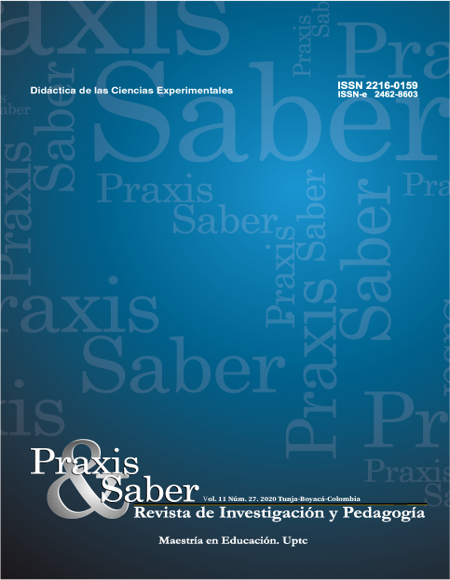Design and implementation of a teaching-learning sequence of the chemical element concept in high school education

Abstract
This article proposes the implementation of a teaching-learning sequence based on the model of learning in the context of an oriented research, in order to improve the teaching of the chemical element concept in high school education. Its design is based on the students’ existing ideas and on the historical analysis about this concept. The evaluation was made by comparing groups of students who followed this didactic sequence to groups of students who maintained a traditional teaching. The results show that the students in the experimental groups compared to the control groups: 1) they present a better understanding of the procedural definition of substance at the macroscopic level; 2) they better define the concept of chemical element within the framework of the Daltonian theory; 3) they better distinguish the concepts of simple substance and chemical element; and 4) they demonstrate a better differentiation of the microscopic concept of mixture—of simple substances or of compounds—when a didactic sequence of constructivist orientation is used.
Keywords
chemical element, junior high school, science teaching, chemistry teaching
References
Caamaño, A., Mayós, C., Mestre, G. & Ventura, T. (1983). Consideraciones sobre algunos errores conceptuales en el aprendizaje de la química en el bachillerato. Enseñanza de las Ciencias, 1(3), 198-200. https://www.raco.cat/index.php/Ensenanza/article/view/50673
Fernández, I., Gil, D., Carrascosa, J., Cachapuz, A., & Praia, J. (2002). Visiones deformadas de la ciencia transmitidas por la enseñanza. Enseñanza de las Ciencias, 20(3), 477-488.
Furió-Más, C. (1994). Tendencias actuales en la formación del profesorado. Enseñanza de las Ciencias, 25(2), 241-258.
Furió-Más, C., & Domínguez-Sales, C. (2007). Problemas históricos y dificultades de los estudiantes en la conceptualización de sustancia y compuesto químico. Enseñanza de las Ciencias, 25(2), 241-258. https://www.raco.cat/index.php/Ensenanza/article/view/87876
Furió-Más, C., & Furió-Gómez, C. (2009). ¿Cómo diseñar una secuencia de enseñanza de ciencias con una orientación socioconstructivista? Educación Química, (Junio), 246-251.
Furió-Más, C., Domínguez-Sales, C., & Guisasola, J. (2012). Diseño e implementación de una secuencia de enseñanza para introducir los conceptos de sustancia y compuesto químico. Enseñanza de las Ciencias, 30(1), 113-128. https://dx.doi.org/10.5565/rev/ec/v30n1.575
Guisasola, J., Furió-Más, C., & Ceberio, M. (2008). Science Education Based on Developing Guided Research. En M. Thomas (Ed.), Science Education in Focus (pp. 173-202). Nova Publishers, Inc.
Heumann, C. & Schomaker, M. (2016). Introduction to statistics and data analysis. Springer.
https://doi.org/10.1007/978-3-319-46162-5
Laugier, A., & Dumon, A. (2003). Obstacles épistémologiques et didactiques à la construction du concept d´elément chimique: quelles convergences? Didaskalia, (22), 69-97. https://doi.org/10.4267/2042/23921
López-Valentín, D. (2008). La enseñanza y el aprendizaje del concepto de elemento químico en la educación secundaria y el bachillerato. Análisis crítico y propuesta de mejora [Tesis doctoral inédita]. Universitat de València, España.
López-Valentín, D. (2013). Presencia de la visión ahistórica y aproblemática de la ciencia en la enseñanza del concepto de elemento químico. En C. Celestino & M. Brzenzinski (Orgs.). Aprendendo ciencia e sobre sua natureza: abordagens históricas e filosóficas (pp.451-460). Tipographia Editora Expressa.
López-Valentín, D., & Furió-Más, C. (2013). Diseño de una secuencia de enseñanza para introducir el concepto de elemento químico en la educación secundaria. Enseñanza de las Ciencias, (Extraordinario), 1997-2001. https://www.raco.cat/index.php/Ensenanza/article/view/307672
López-Valentín, D., & Furió-Más, C. (2020). Desarrollo histórico y epistemológico de los conceptos elemento químico, sustancia y sustancia simple (Primera parte). Educación Química, 31(4), 131-143. http://dx.doi.org/10.22201/fq.18708404e.2020.4.75258
López-Valentín, D., & Furió-Más, C. (2021). El concepto actual de elemento químico: ¿uno o dos significados? Implicaciones en su enseñanza. Segunda parte. Educación Química, 32(1).
McComas, W., Clough, M., & Almazroa, H. (1998). The role and character of the nature of science in science education. En W. McComas (Ed.), The nature of science in education, rationales and strategies (pp. 3-39). Kluwer Academic Publishers.
Méheut, M. (2004). Teaching-learning sequences: aims and tools for science education research. International Journal of Science Education, 26(5), 515-535. https://doi.org/10.1080/09500690310001614762
